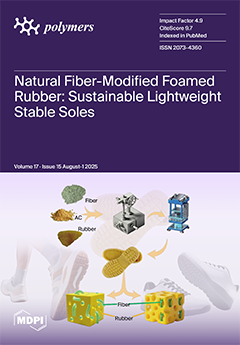This study investigated the effects of color shade and curing time on the degree of conversion (DC) and microhardness of colored compomers. A total of 162 samples (81 for DC, 81 for microhardness) were prepared, with nine samples per color group (gold, blackberry,
[...] Read more.
This study investigated the effects of color shade and curing time on the degree of conversion (DC) and microhardness of colored compomers. A total of 162 samples (81 for DC, 81 for microhardness) were prepared, with nine samples per color group (gold, blackberry, green, pink, orange, lemon, blue, silver) and for the control. Samples were subdivided into three polymerization subgroups (3 s/3200 mW/cm
2, 10 s/1000 mW/cm
2, 20 s/1000 mW/cm
2). The DC was analyzed via fourier transform infrared spectroscopy (FTIR) and microhardness was measured using Vickers testing. Statistical analysis included two-way ANOVA and Spearman correlation (α = 0.05). The colored compomers demonstrated a significantly lower DC compared to the control group (
p ≤ 0.001). Among the tested colors, green exhibited the lowest DC (33.3%), while orange showed the highest (51.0%). A significant difference in DC was observed across curing times (
p = 0.005), with the 3 s and 20 s groups exhibiting significantly higher conversion rates than the 10 s group. Microhardness values exhibited significant variation depending on the color (
p < 0.001). Gold compomers demonstrated the lowest microhardness, whereas silver compomers showed comparable performance with the control group (
p = 0.154). A moderate correlation between DC and microhardness was observed overall (ρ = 0.42,
p = 0.003). However, the observed relationships were color-dependent: orange displayed a strong positive correlation (ρ = 0.78), whereas pink revealed no meaningful association (ρ = −0.15). Color and curing time critically influence compomer performance. High-intensity short curing is viable for lighter colors, while darker colors require extended curing. Customized protocols are essential to optimize clinical outcomes in pediatric dentistry.
Full article






